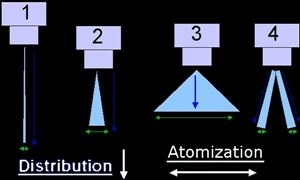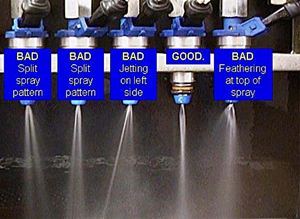DIY Fuel Injector Cleaning is a process that can be accomplished fairly simple and easy. That’s to say if you base it on YouTube videos and some internet sites. An on-off switch is connected to a battery. The other side of this switch is then connected to the fuel injector to be cleaned with a set of wires. The injector is opened and closed by pressing the switch. While the injector is open carb and choke cleaner is then forced through the injector with a syringe. This is done a couple of times per injector and BAM!…. instant results.
Not so fast.
DIY fuel injector cleaning projects are almost always a failure, dangerous and pose a fire hazard. DIY’ers do not have the proper equipment to test, measure, verify and clean the internals of the fuel injectors. With the proper fuel injector cleaning equipment and chemicals it takes the professionals about 45 – 60 minutes of actual cleaning time to clean a single or set of fuel injectors. During this time the injectors are opened and closed 20 000 to 30 000 time whilst they are inside an ultrasonic bath. Do you really believe that a couple of squirts with carb and choke cleaner can achieve the same result?
By the time the DIY’er collected, made and or purchase the necessary equipment to make the injector cleaning attempt successful they would almost always have spent more time and money than what it would have cost to send the injector set for professional fuel injector cleaning.
The most important factors to check when cleaning fuel injectors:
Besides current draw, cracks and other obvious problems,
- Leaking fuel injectors: Does the fuel injector pintle, ball or disc properly seal or seat under operating pressure, thus preventing the fuel injector from leaking.
- Volume: The amount of fuel delivered under operating pressure and under various loads.
- Atomization: How well the fuel being delivered is atomized at various rpm.
- Distribution: The length or depth and the width of the spray pattern.
In most instances the DIY’er does not have the ability to accurately and under operating pressure, measure how much fuel the injector delivers before and after the cleaning process. There are some that recommend that theses test been done using the fuel rail and fuel from the vehicle. This recommendation is irresponsible, dangerous and pose a real fire hazard that could cause severe injuries or even death.
If you want to save time and money read our article on fuel injector cleaning methods.
Or ……..call us today at 1-800-381-2065
DIY Fuel Injector Cleaning at Home
Cleaning fuel injectors by soaking them in, or flushing them with carb and or brake cleaner does absolute nothing. It might flush out “some” loose dirt and grime but, that’s about all. If, as suggested in some of the YouTube videos, you start the DIY fuel injector cleaning process at the inlet side of the fuel injector there is a very good chance to lodge loose dirt and grime between the pintle and pintle sleeve.
100% of fuel injectors we have tested after they were cleaned via a DIY fuel injector cleaning project failed the minimum acceptable performance standard for that specific fuel injector.
Fuel injector Atomization and Distribution
Visual inspection of fuel injector spray patterns
The injectors in the image flow exactly the same amount of fuel. It is the spray patterns that is noticeably different.
The engine should perform properly because all the cylinders are getting the same amount of fuel but not so. Fuel atomization and distribution factors were causing this engine to throw misfire codes. Engine performance was noticeably down. These problems can never be picked up during a DIY fuel injector cleaning project.
Leaking Fuel Injectors
Last but equally important is the ability to check if the fuel injector pintle, disc or ball properly seal under operating pressure. Leaking fuel injectors are a fire hazard and can cause many serious and expensive problems.
Time, money and resources invested in the DIY fuel injector cleaning project almost always will cost more than what it would have cost if the fuel injectors were sent to a professional fuel injector cleaning and flow testing facility such as Injector Rx.
How to clean injectors:
Ultrasonic fuel injector cleaning and flow testing is the only process that can guarantee a reliable and complete fuel injector cleaning.
Even with the proper tools, professional fuel injector cleaning equipment and specialized ultrasonic cleaning solutions it still takes us here at Injector RX about 45 – 60 minutes to properly clean a set of injectors. (More if the injectors are particularly clogged / dirty.)
- Fuel Injector Service Order Form
- Yamaha HPDI Fuel Pump Standard Service Order Form
- Yamaha HPDI Fuel Pump Expedited Service Order Form
- GDI Fuel Injector Service Order Form
- E-Tec and Ficht injector cleaning Service Order Form


